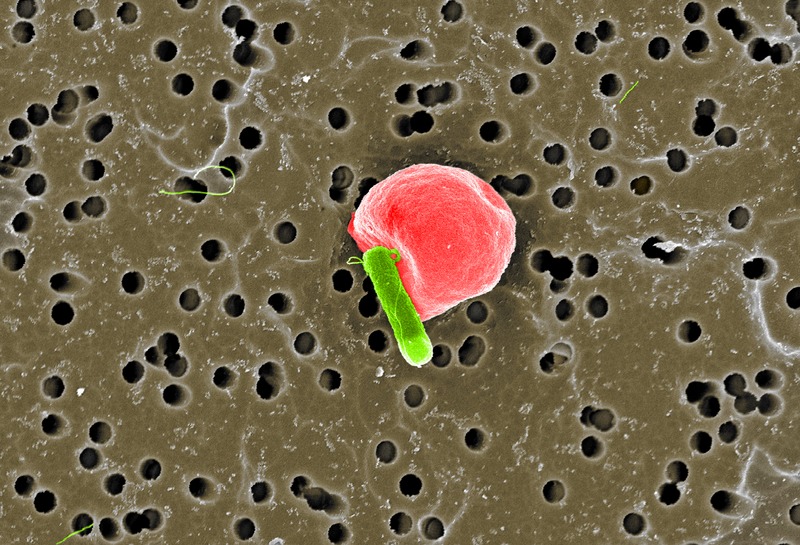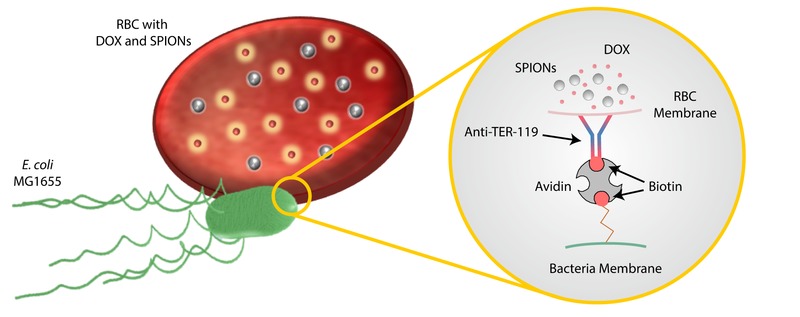The untethered biohybrid microswimmer is able to transport and deliver cargo encapsulated into a guidable red blood cell, while an attached bacterium, one of the most efficient swimmers in nature, acts as a propeller to move it forward. Once it has reached its destination and delivered its cargo, the scientists can destroy the microswimmer using infrared light.
Stuttgart – Researchers of the Physical Intelligence Department at the Max Planck Institute for Intelligent Systems in Stuttgart have developed a multifunctional microswimmer built out of two parts with very unique properties: they combine a bacterium (green), one of the most efficient swimmers in nature, with a red blood cell (RBC), a natural carrier inside the human body.
 Electromicroscopic image of a RBC microswimmer
Electromicroscopic image of a RBC microswimmerRBCs have extraordinary capabilities: they have high payload efficiency and can easily deform and squeeze through narrow capillaries that are half their sizes. This was the reason why the researchers selected RBCs when they intended to develop a microswimmer that would meet the criteria of high load-bearing capacity and flexibility. Combined with the driving force of bacteria – the motor of the microswimmer – it is possible for it to transport cargo even through narrow channels or gaps.

The researchers have encapsulated the cargo in the red blood cell: firstly, the cancer drug doxorubicin as well as iron nanoparticles, for the scientists to be able to magnetically control the microswimmer. Once it has reached its destination, for example a cancer cell, the tumour's acidic environment attacks the membrane of the red blood cell, making it brittle, with the result that the cancer drug is released. The charged cancer drugs are delivered to the doorstep of the cancer cell, so to speak. Once this task is fulfilled, the researchers can destroy the microswimmer by heating it with infrared light so that it decomposes. More on this below.
"Three things make this microswimmer stand out compared to others", says Oncay Yasa, who together with Yunus Alapan has been working on building the microswimmer. Their research publication appeared in the Science Robotics Journal on 25th April with the title Soft Erythrocyte-based Bacterial Microswimmers for Cargo Delivery. "First, its deformability is impressive: the microswimmer can squeeze through narrow gaps of only two micrometers, while in itself being around 6 micrometers large."
"Secondly, the link between the bacterium, the motor, and the RBC, the cargo bay, is very strong due to us utilizing a very strong interaction seen in nature", Oncay Yasa adds. "We use the protein Avidin, which acts as a snap hook, linking on one side to Biotin sticking out of the membrane of the bacteria and on the other side linking to antibodies (anti-TER-119) covering the RBC. That way, there is no harsh chemical reaction while binding the bacterium to the red blood cell. Rather, it´s more like a moveable snap hook system, which attaches the two parts – with Avidin in the middle. That makes the microswimmer ever more robust and flexible than others."
 Avidin connects the bacterium with the red blood cell
Avidin connects the bacterium with the red blood cell"Thirdly", Yunus Alapan continues, "we loaded the RBC with special molecules that can absorb infrared light. When we apply infrared light from outside, the RBC heats up and destroys itself and the attached bacterium. That solves the problem of what to do once the drugs have been delivered. We need the bacterium to be destroyed right away to avoid its uncontrolled proliferation. We don´t want the body defending itself with an immune reaction."
One day, the researchers hope to test their invention inside a digestive system or a stomach, but at this point they have to make due with testing their microswimmers under the microscope. “Biohybrid microswimmers offer great potential in future non-invasive medical operations owing to their untethered steerability, high payload, deformation capabilities, and the possibility of destruction – what we call a "termination switch", says Oncay Yasa. "The microswimmer we developed demonstrates a unique multi-functionality that has not been observed in other bacterium-driven microswimmers before," Metin Sitti adds, the Director of the Physical Intelligence Department at the Max Planck Institute for Intelligent Systems, who worked with Alapan and Yasa on the study. "The presented RBC microswimmers are a great step forward in using soft biohybrid microswimmers in clinical applications, though there still exist challenges to be overcome such as immune response." "Our RBC microswimmer creates the blueprint for the next generation of multimodal, targeted cargo delivery systems." Alapan concludes.
Co-authors of the paper are also Oliver Schauer and Victor Sourjik from the Max Planck Institute for Terrestrial Microbiology, as well as Joshua Giltinan and Ahmet F. Tabak from the Max Planck Institute for Intelligent Systems.


